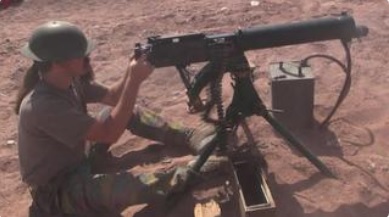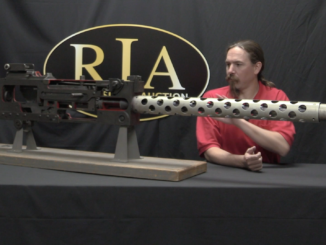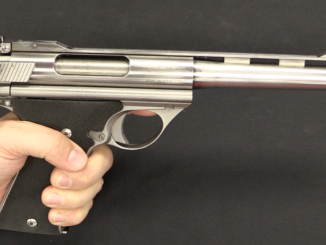Joseph Chambers invented a repeating flintlock weapon in the 1790s, and I think it is appropriate to consider it a “machine gun”. The design used a series of superposed charges in one or more barrels, with specially designed bullets that has hollow central tubes through them. This would allow the fire form a detonation charge to transit through a bullet at the rear and set off a subsequent charge. The result was a single trigger pull to use a flintlock action to start an unstoppable series of shots. Chambers made pistol and musket versions, as well as a full-on mounted machine gun.
He submitted his design to the fledgling US War Department in 1792, but it was not accepted. He brought the guns back to their attention when the War of 1812 was declared, and this time he found an eager client in the United States Navy. More than 50 of the machine guns were built and purchased to use on Navy warships. This version had 7 barrels, each loaded with 32 rounds, for a total of 224 shots, at (apparently) about a 120 round/minute rate of fire. The British found out about the guns and made some effort to reverse engineer them, and there was also interest in France, the Netherlands, and Spain. Ultimately, the potential unreliability of the system prevented more widespread adoption, but the gun is a fascinating example of early automatic firearms.
For more information, see Andrew Fagal’s article “The Promise of American Repeating Weapons, 1791-1821”.
Thanks to the Liege Arms Museum for access to film this for you! If you are in Belgium, definitely plan to stop into the museum, part of the Grand Curtius. They have a very good selection of interesting and unusual arms on display.




If the first charge ignites the other barrels, wouldn’t this mean that all barrels are firing more or less simultaneously and expending all rounds in about 15 seconds? Or is there some system that causes one barrel to fire only after the last one is finished?
Sure seems that way Zach. That would bring the rate of fire up to about what an M-60 would be. 15 seconds would be about enough time to sweep a deck end to end pretty thoroughly. Two or three guns doing so would be pretty effective I’d say.
Al
I think that 120rpm rate-of-fire isn’t per barrel, it’s net for the gun. So an individual barrel wouldn’t be spitting out 2 rounds per second; it’d be more like 3.5 seconds per round — perhaps slightly less, since the higher-numbered barrels would start and finish a couple seconds later than the first. I’d imagine it would sound more like a popcorn popper than a modern machine gun, with some shots almost simultaneous, and lulls of a second or two between others.
This is exactly what I thought, you would essentially have a volley of 7 shots, with 1, 2-4, and 5-7 being so close together as to be indistinguishable, so you’d hear seven at a time. So if the entire sequence takes 2 minutes, you would hear a volley every 4 seconds or so, on the other hand if the rate is indeed 120 per minute total shots fired, the entire thing would empty itself in about 15 seconds – that sounds far more likely. Still confused.
To clarify and confuse further – mean the rate at which you hear the bang(s), not total shots fired, in other words, if you just had one barrel, and it fired at 120 shots a minute, it would only take about 15 seconds to fire 32 shots… just curious, would it sound like a steady rate of fire or blurp, tripple-blurp, tripple-blurp, repeat? or would those be close enough together that all 7 sounded like a single shot?
The bullets are cylindrical with a tail. there is a thin hole through the middle of the cylinder and tail. the fire transmits from to back thorough those holds. think of a Roman Candle firework.
Any barrel failure would result in a nasty mess, which would take quite a while to clean off the deck of a ship! The Metal Storm concept, even in old clock-punk form, still fails to deliver on practical and cost-effective firepower. I could be wrong.
freaking sweet video!
If (WHEN) it misfires – something that will likely happen in 224 attempts at firing any flintlock, even one not dependent on novel notions of ignition through long narrow bullet tubes (which I’m sure were PERFECTLY consistent in 1814), i.e. likely to occur at least once EVERY time you touch the thing off – you have a dead piece of crap with dozens if not hundreds of live charges buried deep inside and aimed right at the only access point(s).
If the misfire isn’t the first shot, the live rounds are now nowhere near the lock / means of trying again.
Theoretically one could (AFTER disengaging from the enemy / waiting for the powder embers to smolder out) top it up and try to clear it that way. Even if the gunner is perfectly attentive to counting the shots going off (in the heat of battle), ignition is not perfectly sequential, so there’s no telling whether the (say) fourteen shots that he heard are two perfect salvos from the first two layers, or 1+2+11, or any permutation in between. It’s not as though it depends for safety on precisely how deeply each charge is loaded . . . oh, wait, that’s critical too.
And you have to keep it loaded before battle. I’m sure (even though we still can’t develop a cover that will keep a machine gun from rusting in a shipboard mount in 2019) that in 1814 they had a flawless method of keeping it dry. Or maybe they just had a perfect means of predicting battles in sufficient time to ram 224 charges to 32 different depths.
You could count the remainig live rounds by using a gauge something like a maked stick then refill the barrel for another round.
True – but that would be a lengthy and involved process that one could only pursue after breaking off from the battle.
That would leave the crew having to either blow 224 rounds (hoping that it wouldn’t misfire yet again) for nothing, or leave all those charges to degrade in the damp salt air for the vague possibility of future action – and the virtual certainty of unrecoverable misfires if that didn’t happen in the next few days.
The Danish army and navy had a similar setup about that time, called an “espingole”;
There was also the American Kesling patent, as mentioned in the chapter from the Winant book. The question seems to be, who came up with the idea first?
cheers
eon
A fuse in the bore-hole, rather than a continuous mass of powder, would help control the discharge rate. But would also multiply opportunities for hanging fire.
The whole thing looks so dangerous that I’m amazed there aren’t a bunch of anecdotes or reports.
Now this is ironic history. A flintlock machine gun, mounted on the warship Constitution. Perfect.
Somewhere, someone in the NRA-ILA must be grinning about this story.
The rifle shown in the diagram has a second lock at the rear. Probably for use as a single shot after the machine gun firing, not as a way to liven up the shooters day by clearing squibs. The screws on the backplate of the pintle mounted gun could allow clearing unfired rounds.
If you are closing on an enemy to get within range and are only slightly faster, that could allow enough time to load the gun before battle.
The smoke could be fairly heavy so the sights being larger than usual makes sense, although shooting up the rigging might the guns alternative use.
How did the touchholes between the barrels get cleaned? What the hell did they do to clear misfires?
Inquiring minds would like to know…
My guess would be pretty much the same as with any flintlock:
1. Hot soapy water and a patch on a cleaning rod.
2. Screw on a cleaning rod. Having a projectile with a central hole would make this task a little easier than usual.
Regardless, this thing is not going to get cleared when mounted up in the tops.
C’mon Eon, load it up and give us a demonstration!
My first thought was that somebody stuck a flint lock on the side of a WW2 German Fliegerfaust. Then I realized the barrels were octagonal, not round.
The Royal Navy had seven-barreled, shoulder-fired “volley guns” in the maintops of their men o’war at the time, for clearing an enemy deck of would-be boarders or gun crews. Something like this, swivel-mounted in the fighting tops, would probably do that even more effectively, firing 237 more rounds than a volley gun with each “shot”. In fact, the RN’s use of those seven-barreled volley guns may have been the impetus for the fledgling USN to buy these gadgets.
It’s just one more example of how the concept of the “machine gun”, and its tactical use, has been around a lot longer than the technology that made it practical.
cheers
eon
The bullets in the French diagram appear to be spherical rather than cylindrical. Thus the loader would, along with other finicky details, have to be VERY sure he rammed each bullet with the channel parallel with the bore — or close enough for the serial ignition to work.
What caliber? Looks pretty sizable in the video.
Also: That’s the first time I ever saw toothed jaws on a flintlock. How’d they make that?
What are you supposed to do if your commanding officer yells, “Cease fire!”?
“WHAT!? I CAN’T HEAR YOU!!”
Hope it’s the XO and the CO responds with “Belay that order”.
Of course, back then, the naval environment (Napoleonic- “I hear there’s a wicked war a’wagin”) tended to be rather Darwinian and rarely selected for “clinically thick”.
cheers
eon
I recall reading about earlier “Roman candle” guns similar to Chambers’ original design, but using multiple barrels instead of the special bored-through bullets. The idea was that you’d have perhaps 4 barrels, the top having a single port drilled through to the bottom barrel, near the muzzle, and the bottom barrel having multiple ports leading to the side barrels. The top barrel would be loaded with one round, the bottom with just powder, and the side barrels with as many shots as they had ports (perhaps three or four each).
When fired, the flashover from the first barrel would ignite the powder in the bottom barrel from the muzzle end, which would then act as a fuse, sequentially igniting the rounds in the side barrels. If all went well (just as big an “if” as in Chambers’ gun), you had a nice little 7-9 round burst from your weapon. If not, you had a disappointment, or an explosion. All those barrel ports likely made it a pretty major cleaning undertaking, though.
Seriously, what caliber? Looks like about .75.
Using approximately Brown Bess loading data, about 22 pounds of lead and seven of powder every “shot”.
Great post. Thanks for sharing this information, I really needed it for my project with http://essaydiscountstore.com/ and you really saved my time!